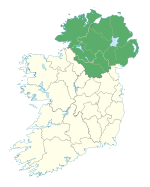This article needs additional citations for verification .(September 2016) |
| Derryveagh Mountains | |
|---|---|
| Irish: Cnoic Dhoire Bheatha | |
 Loch Ghleann Bheatha in the grounds of the castle at Gleann Bheatha | |
| Highest point | |
| Elevation | 751 m (2,464 ft) |
| Coordinates | 55°01′N8°03′W / 55.017°N 8.050°W |
| Geography | |
 | |
| Country | Ireland |
| Provinces of Ireland | Ulster |
The Derryveagh Mountains (Irish : Cnoic Dhoire Bheatha) are the major mountain range in County Donegal, Ireland. It makes up much of the landmass of the county and is the area of Ireland with the lowest population density. The mountains separate the coastal parts of the county, such as Gweedore and Glenties, from the major inland towns such as Ballybofey and Letterkenny. Its highest peak is Errigal. [1]

